All about backup Android applications. How to backup applications and data on an Android device on the example of a Samsung Galaxy S4 smartphone
Contacts, photos, progress in games - smartphones contain no less necessary information in their memory than hard drives computers. Backup Android allows you to eliminate the loss of important data, securely storing them on Google servers or on a computer.
Backup to google servers
For the full-fledged work of Android, you need a Google account - a Gmail mail account, with which you can log in to any service from a global corporation. Therefore, a backup copy of Android in Google is the easiest way to save content and settings. To back up contacts, data of some applications, calendar and disk, just add a Google Account in the settings and enable synchronization.
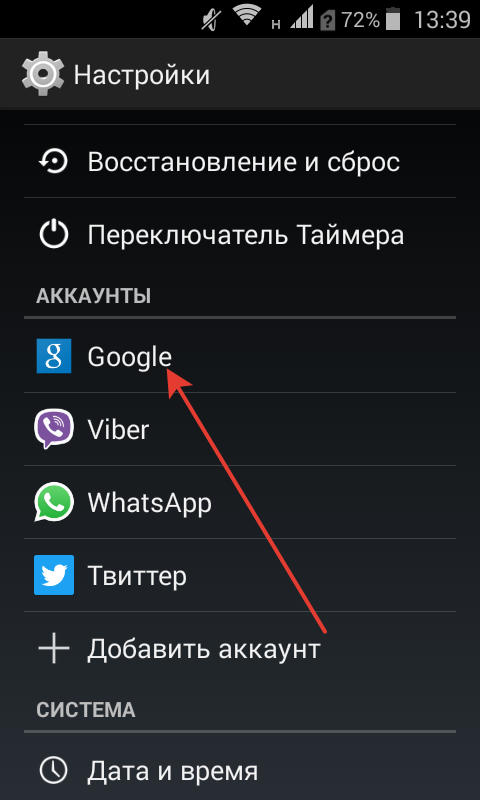
Marked data will be automatically saved to Google servers. To restore them to your phone from backup or transfer to another device, just add an account and enable synchronization. 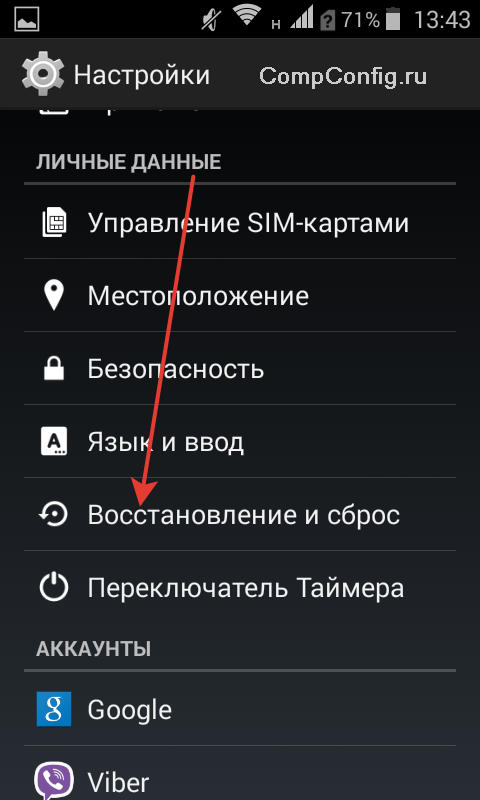
In the settings of the phone there is also a “Restore and reset” section. Here you need to enable backup, add a Google account to sync and activate auto-recovery, which will help to restore a copy of the settings and data of some applications when they are reinstalled. 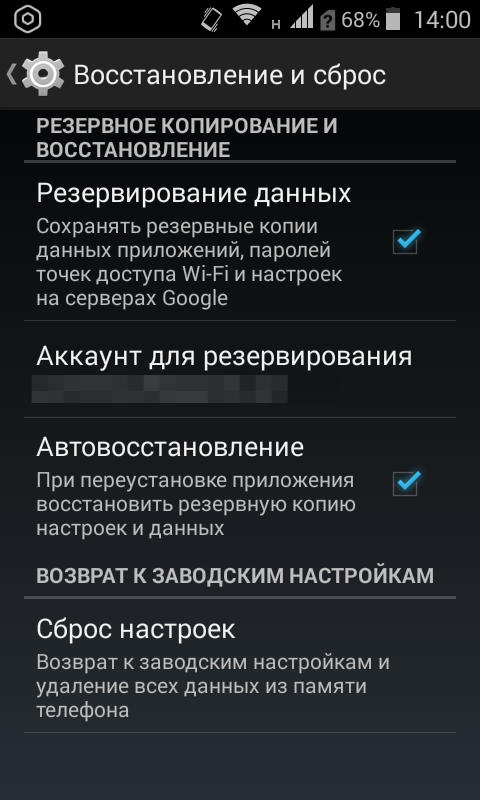
On Google servers, important information is saved, but, for example, the progress in the game can not be transferred to another device using this synchronization. If you want to save absolutely all the data, then you need to know how to make a full backup.
Backup via Recovery
The standard Android recovery menu (Recovery) has extremely limited functionality — resetting settings and installing updates. But if you put an alternative Recovery (for example, Clockworkmod) on your phone, you can perform a number of operations, including backup. In fact, it will not be a backup copy of the data, but a full-fledged copy of the system. 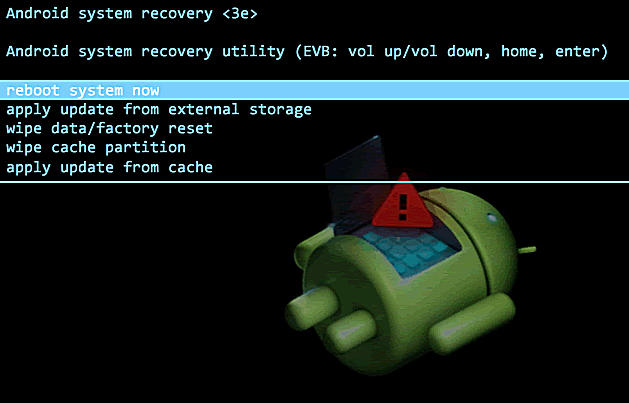
If you do not know what a custom Recovery is, and you have never installed it, then it is recommended to immediately proceed to the next item in the guide, which describes how to create a backup using the Android backup program on a PC, called Adb Run.
If you have a custom Recovery, then it will not be difficult to make a cast of Android:
- Turn off the phone, go to Recovery (usually you need to hold down the "Volume +" and "Power" keys).
- Using the volume rocker and power button, open the “Backup and Restore” section.
- Select “Backup” to create a copy of the current firmware status.
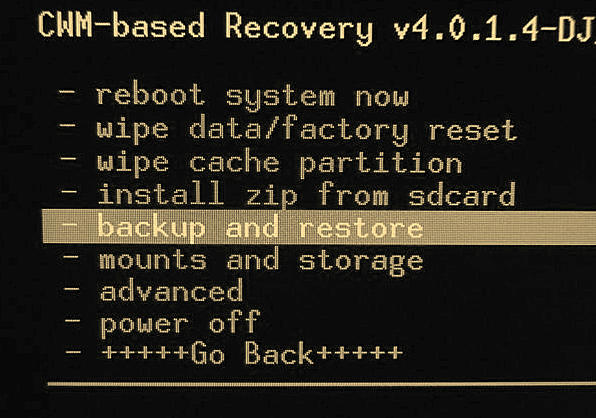
The backup will be saved to a memory card, to a folder with the name “CWM” or “TWRP” depending on what Recovery costs. Then there are two options:
- Store the system image on a memory card.
- Connect the phone to the computer and transfer the backup to hDDin order not to overwrite the memory of the mobile device with a large amount of data.
To perform a restore android data after backup through Recovery, you need to make sure that the image of the system lies in the corresponding folder on the SD card. Then you should go back to Recovery, open the “Backup and Restore” section and go to the “Restore”. A list of available to restore backups will appear, from which you need to select the appropriate system snapshot.
Using Adb Run
If you want to run backup copy android to the computer, bypassing the creation of a backup in the Recovery menu and setting google account, then use the free utility ADB RUN. For it to work, two conditions must be met:
- On the phone, USB debugging is enabled.
- Mobile device drivers are installed on the computer.
Drivers must be for the model that you connect to the computer. If the conditions are met, you can proceed to create a backup.

The backup is stored on the computer in order to return the data to the phone, you need to run Adb Run again and go to the “Backup” section. Here you should open the subsection “Adb Restore” and select the desired backup, after which the data will be copied back into the memory of the mobile device and to the SD card. 
Ways to create a backup on Android are not limited to the described tools. AT Play market You can find a dozen applications (with or without root) that allow you to save different amounts of data — Safe Backup, Super Backup, Titanium Backup. But before applying the capabilities of the application, be sure to read user reviews about its work - some programs are unstable.
Due to the fact that I work with several devices on android’e at once, I often have to transfer information from one gadget to another. And there is little good in it: too many unnecessary gestures. And if we take into account that most of the time it takes me to write scripts and shoot videos for the revolverlab site, smartphones have to be changed very often, and a lot of precious time is lost on setting up the next gadget.
Of course, you can hope that the data will be saved automatically in the Google storage cloud, from where you can get it in case of damage to the gadget or the usual transfer of data to another device. But on the other hand, nothing can be sure, and especially in the reliability of such a repository. Therefore, I began to search for an adequate backup application.
And search good android applicationI tell you, the task is not simple. At first glance, the choice is large, but in reality, only a few are able to perform simple functions efficiently and efficiently.
Fortunately for me, there was a way out - a third-party Helium application that allows you to easily backup to a smartphone's memory card, another device on the Android OS, various online file storages, or to a personal computer.
In this tutorial, I will show you how to configure an application on a smartphone under running Android, and how, in fact, it works. So, let's begin.
1. Download from Google play Store application to sync and backup called Helium and install on your smartphone.
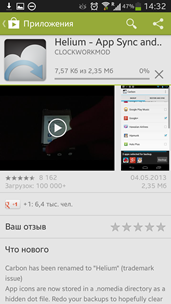

2. Download Helium to computer. If your device has root-rights, you can skip this step. If the drivers are not installed on the PC, download them from the manufacturer’s website, in my case it’s Kies for Samsung. Next, download and install the Helium Desktop App and open it. The application is on both Windows and Mac.

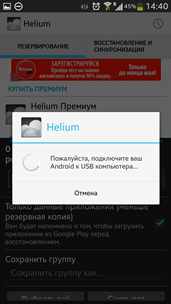
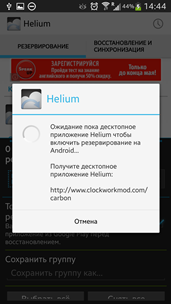
3. Make backup copy applications. To do this, open the "Helium" on your device. You will be prompted to download Helium for PC, however we have already done this, but if your HTC will have root-rights, this will not be necessary at all. If you are not “rooted”, connect your smartphone to your computer using USB.
You have options: save all the information or select applications individually. You can also choose to back up an application with data or just data. This option will be relevant if you want to save space on your gadget.
When you make a selection, you can click the "Backup" item. Information can be saved on internal memory, Sd card, dropbox. You can copy data to a computer. To do this, click the "menu" and select download PC. You start the server that gives you the IP address. It also needs to be placed in your browser in the address bar.
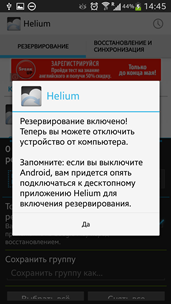
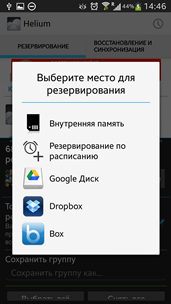

Going to this address in your browser, you will see a simple interface. As you can see, nothing complicated. You can easily drag and drop backups to a web page.

4. Restoring backup data or applications.
To back up with this application, simply click on “Restore and Sync”. Next, select the place where you want to install the backup.
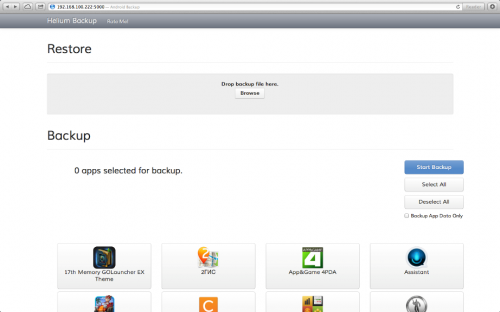
![]()


Now you can, without wasting precious time, restore applications and data when updating or replacing a damaged phone.
An article about how to make backup copies of important data on your Android device in advance and restore them in case of system failure or flashing.
Modern smartphones, although they got a full-fledged operating system (for example, Android), all the same, in the first place, remain telephones - means of communication. They keep all our contacts and emails. This data does not want to lose, but sometimes there are various failures and breakdowns that lead to almost complete erasure of the device's memory ...
If you have encountered such a situation, then you probably know how difficult it is to literally re-create all the necessary data. However, this could not happen if you had attended to the creation of backup copies in advance!
In today's article, we’ll talk about how to backup Android in general and its individual databases (for example, Contacts, Messages, etc.) in particular.
A bit of terminology
Before you begin directly to the practice of creating backups, it is useful to understand a little about the terms that we will meet. The key ones are "" and "recovery".
"Ruth" (from the English. "Root" - "root") - a concept known to most users of systems based on the Unix kernel (including Android). It implies that the user has access rights to the OS root directory and the ability to modify files in it.
If you have a root on your device, then you can create some backups as simple as possible even without third-party software. Without rights, you can also create some backup copies, however, it is not so convenient to do it. Therefore, obtaining a root is highly desirable.
"Recovery" (from the English. "Recovery" - "recovery") - a term referring to purely mobile devices. This is a menu system that resembles a computer's BIOS, which boots up to booting the system itself and allows you to install service packs, restore backups, or clear the device’s memory.

Recovery can be staffed (that is, standard for a specific firmware) and custom (Clockworkmod Recovery (CWM) and Team Win Recovery Project (TWRP) are the most popular). Custom recovery usually contains more features, but does not exist for each device. Yes, and the installation of the existing one does not guarantee success, since by performing various manipulations at the firmware level you risk disrupting the performance of your device.
Backup contacts
Backing up phonebook contacts in Android can be called one of the simplest tasks in terms of backup. This is facilitated by the fact that everything is stored in a simple database of the popular SQLite format in one real file, which, if there is a root, can be easily copied directly from the phone to a PC.
There is a database with numbers in the root directory at the address: /data/data/com.android.providers.contacts/databases/ and has the name "contacts.db" or "contacts2.db" (depending on the firmware):
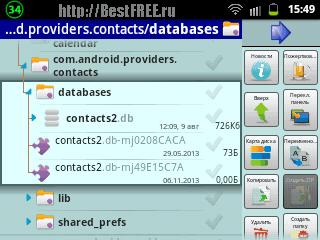
You can copy the above file, save it on your computer and even edit it with special programs (for example, free SQLite Studio):

However, it is not necessary to have a root or rummage in the root folder in order to backup the phone book. It is quite easy to export it by regular means of import / export. To do this, open the contact list, call its menu and find the item "Import / Export" in it, activate and select where you want to save (or where to restore) the phone book:

The result of such simple manipulations will be a file of the vCard format, which can be used both to restore the contact database in the phone, and for viewing on a PC.
Go to "Settings" - "Accounts and sync", click on your account and on the screen that will open you will be able to synchronize contacts, gallery (you need to connect to the Picasa service) and Calendar:

Naturally, there are other ways to save phonebook backups. To do this, you can use numerous applications for Android (for example, Super Backup: SMS & Contacts) or Windows (for example, MoboRobo). But we will talk about them a bit later, since their specialization is quite broad.
Backup messages
Often our SMS-correspondence can be no less valuable than the phone book. Through SMS, we can receive and send important passwords, phone numbers, etc. Therefore, backup SMS can sometimes be very necessary action.
Unfortunately, there are no regular tools for importing and exporting messages to Android. However, if you have root, you can copy the database with your correspondence from the root folder to the address: /data/data/com.android.providers.telephony/databases/mmssms.db.
If there is no root, you will have to resort to help. third-party applications for Android or Windows. One of top apps for Android in this area is SMS Backup & Restore:
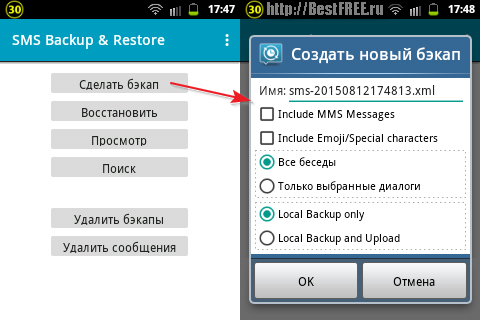
The application allows you to create backup copies, view them and, of course, restore. Among the additional amenities specifically SMS Backup & Restore worth noting:
- the ability to backup only selected conversations;
- text search function in backups;
- mMS backup;
- preservation of message formatting;
- the ability to select the storage location (internal memory, external SD card, "cloud" services).
The application is intuitive, does not require root and works on almost any device.
Application backup
In addition to storing phonebook backups and messages, often application backup. In principle, if you are connected to Google Play and download applications only from there, you can use the installation history and re-download everything that you had. However, it often happens that we establish what is not on the Playmarket ...
In this case, you can do in several ways:
- Use proprietary software for PC (like, KIES for Samsung).
- If you have root, save the application APK files to your PC or memory card.
- Use special applications for Android.
KIES is certainly a useful thing, but it does not work with all devices. Therefore, I cannot recommend it as a universal one, alas ... There is the MoboRobo phone manager already mentioned, however, he refused to work with my phone (even after installing the drivers).
Therefore, we proceed immediately to the option with the presence of the root. In this case, we can go to file system and manually save all the necessary APK files. Depending on whether this system application or third-party, as well as where it is installed, you need to look in one of three places:
- System: root / system / app /.
- Third-party installed on the phone: root / data / app /.
- Third-party, moved to the memory card: mnt / asec /.
Having found and saving the necessary applications, you can easily install them in the future. And not to search manually in some file managers (for example, Total Commander) a list installed programs already moved to a separate section:
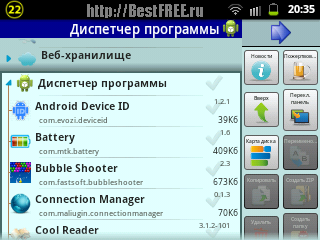
If there is no root, and somehow you need to make a backup, then the most universal way to do this is to use special applications, like Super Backup: SMS & Contacts:
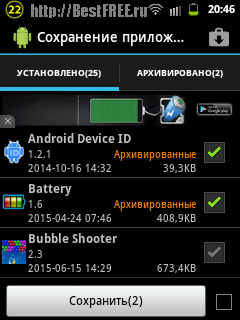
This application allows you to make backups:
- applications;
- contacts;
- messages;
- call log;
- calendar;
- bookmarks.
That is, if you do not have root, then this application will help you to archive almost everything except system files. However, if you have Super Backup root: SMS & Contacts can not only save application APK files, but also include all your files in the archive settings! Given that the application weighs a little (a couple of megabytes), I can recommend it as a "must have" on any Android device.
Full backup system
Making a full backup of your Android device is not easy. Really full backup provides for the preservation of the firmware image and everything that is installed on the device.
This can be done only with the help of a special console utility ADB (abbreviated from the English "Android debug bridge" - lab. "Android debug bridge") or custom recovery (in the standard copy / restore tools not).
The main difficulties of using ADB are:
- the need to install a driver for your device;
- selection and configuration of the desired package of console applications;
- need for knowledge of ADB teams and the principles of breakdown hard drive in a unix-like environment.
If you still decide on the full backup data way, I recommend that you familiarize yourself with the matter. Well, Google, of course, has not been canceled by anyone :)
The second method using custom recovery is much easier. The capabilities of the popular CWM and TWRP already include creating backup copies of the entire device and restoring them. The main problem is that the above-mentioned recovery does not exist for all models of devices.
If you are lucky, and among the models declared on the official websites, your device is listed, then installing custom recovery is quite simple. Download the update.zip archive and place it in the root of the memory card, then turn off the phone and boot into regular recovery mode (on my Samsung galaxy Y for this you need to turn on the power button with simultaneously holding the central and volume up buttons).
In your recovery, find and activate the item "apply update from sdcard", "install update", "install zip" or something similar. After that, select the downloaded archive from the recovery and wait for a while until all the updates are applied.
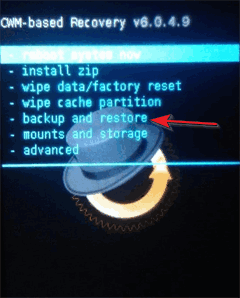
In the new recovery you will have the item "backup and restore", which is responsible for creating backup copies and restoring the device with their help.
Above, we have considered, so to speak, more hard options for backup, however, almost a full backup can be made by means of installed applications. One of the most powerful and popular in this category is:
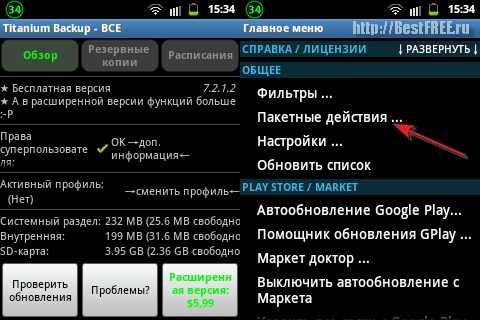
This application allows you to make the most complete backup copies of the user-installed and system programs with the preservation of all the settings, but always requires root-rights. The only thing that Titanium Backup does not save is the firmware itself, so it is worth noting that, sadly, you will not be able to do an absolutely complete backup.
On the main screen of the application there are three tabs: "Overview" with a list of features, "Backups" with a list of installed software and its backup marks, as well as "Schedules", where you can set the frequency of automatic backup. However, all the real power is in the Titanium Backup menu, and more specifically in its “Batch Actions” section:
![]()
We are interested in the section "Backup" and the item "Make rk all user software and system data." The number on the right displays the number of applications being archived, and the Start button on the left allows you to start creating a backup. Before launching, you can manually select the programs that should or should not be included in the backup, and then all that remains is to click the Start button again.
In addition to batch functions, Titanium Backup allows you to back up or delete selected applications (including pre-installed ones) manually, as well as create backup copies on a schedule. To do this, use the corresponding tabs of the main screen:
![]()
On the Backup copies screen, notice that all the applications in the list differ in the color of the spelling of their names and the icons on the right. The names of user applications are written in white, and system and preinstalled in red. Also, if a backup was previously created for the application, then on the right you will see a smiley, and under the name of the backup date.
Titanium Backup is the most versatile backup application, but not the only one. You can also try Online Nandroid Backup (full backup), Helium, DataSync and some others that may or may not work on your device :)
Results
So, we have considered almost all the basic ways to backup Android. As you can see, for some types of data (for example, Contacts), there are regular backup mechanisms that do not even require root. And, for example, a full backup of the system, in addition to the root, will require you either to make changes to the firmware of the device, or to master the console ...
Although not everything is so bad. If you are not one of those who almost every week reflash their devices, then in most cases it will be enough for you to save all your applications, contacts and correspondence, which is easy to do with special programs. And, if from those, in any case, sooner or later you will have to get acquainted with the console;)
People say that if I knew where you were going to fall, you would have spread straws. So a timely backup is that “straw” that will always help you to keep your data on your mobile device safe and sound! Therefore, we make backups and may not meet us on the way of a thick polar fox :)
P.S. Permission is granted to copy and cite this article provided that the active link to the source is indicated and the authorship of Ruslan Tertyshny is retained.
10 best backup apps for Android | Introduction
Responsible people will not forget about the need to backup data on a desktop PC, but how many people behave in the same way in relation to their phones? Backing up data on an Android device doesn’t seem to be too interesting, but only until the real problem appears - because your phone can be stolen, you can install the wrong firmware, or just drop your device in a puddle, and then find yourself in a very difficult position . While Google automatically backs up your contacts, mail, and calendars, you can do the same with your programs — both with their data and settings. Today we publish the top ten best backup apps for Android that will help keep your data safe.
10 best backup apps for Android | Helium App Sync and Backup
Cost: Free / $ 4.99
With this program, ClockworkMod successfully debuted in the field of data backup to mobile devices. Like its best counterparts, Helium allows you to reserve programs, contacts, SMS messages and call logs, but, unlike many, it does this without the need for rooting the phone. Non-root users will have to install additional program for the mobile application to work when connected to a PC, and those who have root access can literally immediately take advantage of Helium. The paid version disables ads and includes the function of copying to the cloud, as well as scheduling backups.
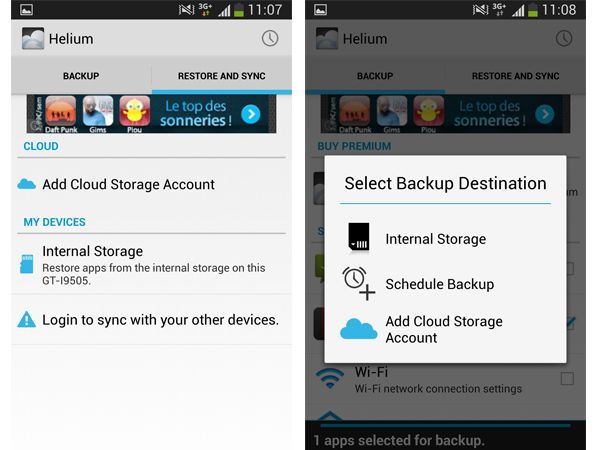
10 best backup apps for Android | Holo backup
Cost: Free
It's not even mobile app, and a program for backing up data for desktops with ADB-functions of Android 4.0, which is responsible for backing up programs and data to a PC, even without rooting the phone. Users can also back up SMS messages and can even backup by wireless connection (although for an ADB backup via Wi-Fi, you need to get root-rights). Holo Backup does not contain any bizarre excesses like backup to the cloud or backup scheduler, so you will have to perform the backup process manually. But the bottom line is that Holo Backup is practical and free applicationwhich does not need rooting.
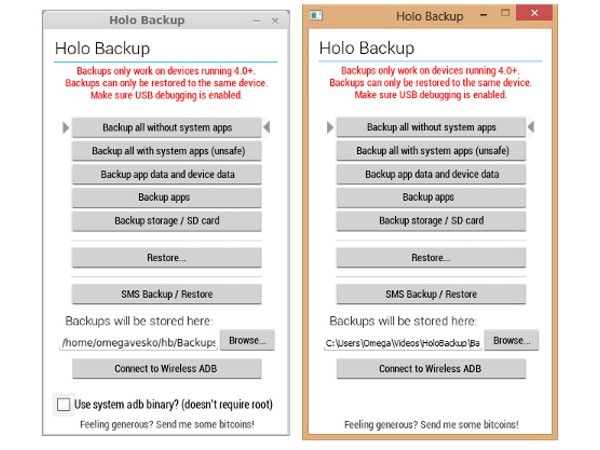
10 best backup apps for Android | Ultimate backup
Cost: Free / $ 2.99
The developers of J. Rummy Apps suggest using a universal application manager to back up programs and information. Ultimate Backup backs up data contained in both local storage and cloud storage (data and settings require root-permissions) when working with Drive, Box and Dropbox. Also, the application contains a built-in uninstaller, the function of the forced completion of processes (“task killer”), the function of cleaning the cache and much more. In addition to backing up applications, you can make backup copies of the call log, browser bookmarks and Wi-Fi settings. Ultimate Backup offers a decent and at the same time free set of system tools even without root-rights, and the premium version contains some additional features, including a scheduler and restore a backup from the cloud.

10 best backup apps for Android | Titanium backup
Cost: Free / $ 6.58
Already spent rooting your Android device or are you thinking about getting root access? Titanium Backup is reliable work application for backup on Android devices, and the free version allows you to back up and restore applications and various data, including contacts, SMS logs, and more, with tools that greatly automate the backup process. The premium version includes many excellent features, including backup and restore from the cloud, as well as an automated scheduler, selective archiving of items and transfer of reserved data to an SD card.
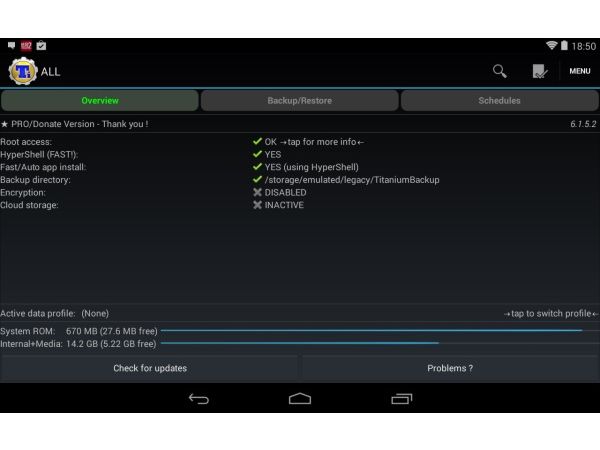
10 best backup apps for Android | My Backup Pro
Cost: $ 3.99
My Backup is another powerful application for backing up and managing data on Android devices. This program includes backup features and an automatic scheduler, as well as the ability to create a backup in the cloud and many other features. Despite the fact that My Backup works fine on phones without rooting, its true potential is revealed on devices with root access, since the user can back up not only applications, but also various data and settings, for example, saved games. In order to try the program in action, you can use the 30-day demo version.
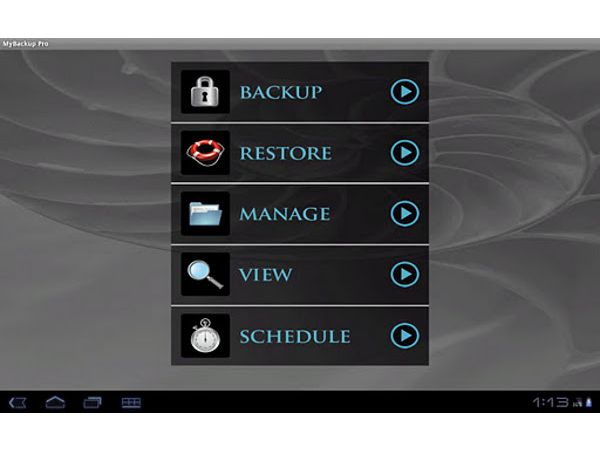
10 best backup apps for Android | Super Backup
Cost: Free / $ 1.99
Super Backup is a fast free application for Android-smartphone that can back up and restore data along with applications and settings (you need root access), to carry out these processes automatically through the scheduler. The backup is stored on the SD card, in the internal memory, on a PC or Gmail (although it will be ridiculous to look for all other data, except for phone data). There is no cloud backup option from Gmail, so importing backups to the cloud, as well as to an SD card or PC, will be your own. The advantage is that all these functions are provided for free, and buying a premium account only serves to get rid of advertising.

10 best backup apps for Android | Gcloud backup
Cost: Free
If you need to save mostly not programs, but photos, music, videos, contacts or a call log, then GCloud Backup will satisfy your needs. Users need to create a special GCloud account that provides 1 GB of free backup space (with the possibility of expanding it when you buy a premium account), and all you need to do is select the necessary information for the reservation, which will then be automatically copied to your account. . The backup process can be done using the scheduler, and viewing in the cloud - through an account in the cloud service.
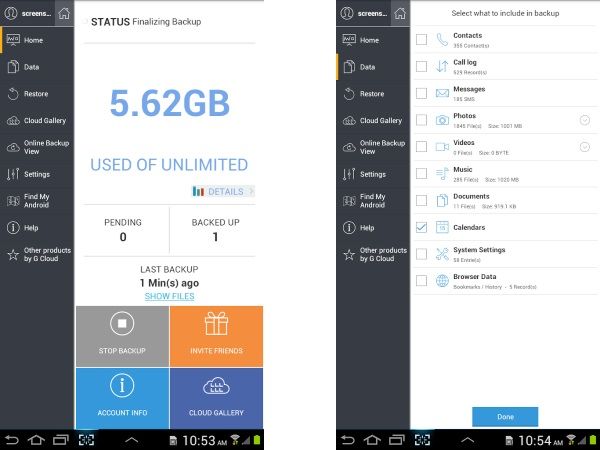
10 best backup apps for Android | Mobile Backup & Restore
Cost: Free / $ 1.99 per month.
Mobile Backup & Restore is something new from Avast in the field of Android backup applications. Free version allows you to backup contacts, SMS messages, call logs and photos, and with a monthly premium account you can use the same functions for music, video and applications. Mobile Backup & Restore stands out among others due to its task scheduler and automatic functions that are easy to set up, as well as a variety of options for implementing full or selective backup to Drive and Avast servers. Users with root access and premium accounts can save application data. In general, the program from Avast is not as demanding as some others, and is also one of the easiest to use.
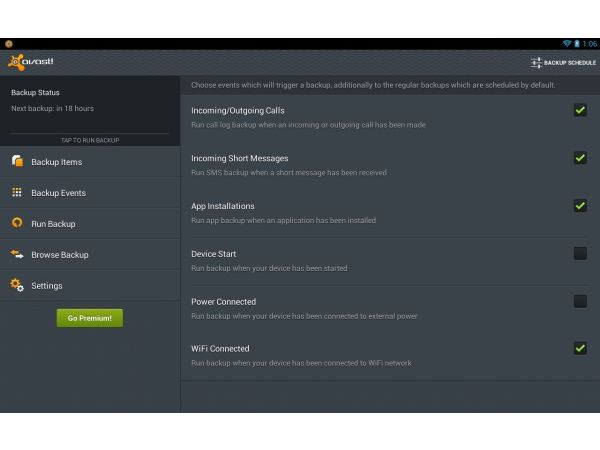
10 best backup apps for Android | SMS Backup +
Cost: Free
If you are only interested in saving SMS messages and a call log, then you should try SMS Backup. The application automatically synchronizes SMS, MMS and call logs with a Gmail account, marking each group with tags. Automatic backup settings allow you to adjust the time and frequency of backup messages, which can then be restored using tags. And although this application does not have such an extensive set of functions as many other programs (though some users report problems with KitKat), it makes it very easy to make an additional copy of messages and call logs.
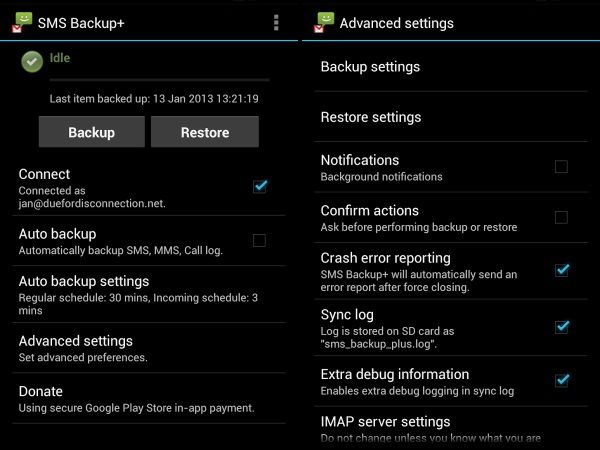
10 best backup apps for Android | ROM Manager
Cost: Free / $ 5.99
Another program from ClockworkMod this time is not an application solely for backup, but it is a powerful system tool for rooted devices that can virtually completely clone the software part of your device in its current state. In addition to creating backups, you can view their contents and restore the firmware. And although this program is not as focused on implementing the backup process as specialized applications, the ROM Manager functions are perfect for users who like to tinker with custom firmware and Android variations, since you can create system restore points with this program and use them if you need to bring your machine back to life.
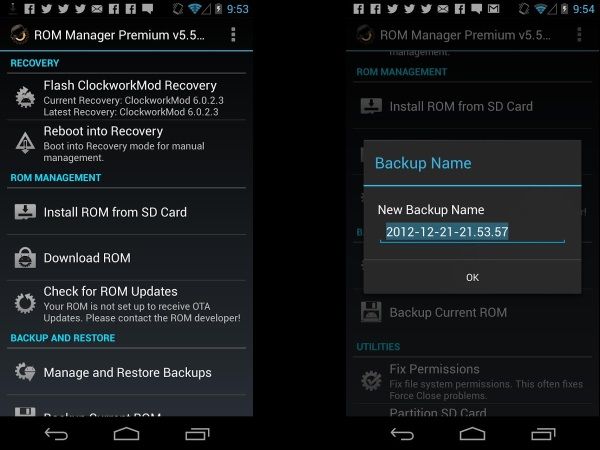
When it comes to creating backup data or restoring to quickly and reliably, many Android users think about what and how, in this article you will find many ways to and with what to backup and recover later!
Why backup?
1. On your personal Android, a lot of information can be stored which is very valuable for, which is either not allowed to be lost or for example you are planning to move from one Android devices on the other! Of course, when it comes to Google services, for example, everything is very simple, I entered my login and password, I waited 2 minutes for it to be completed synchronization with google server and the data is all in place, but with other applications you will have to suffer in order to quickly make a backup and recover.
Method # 1 - backup to Android and restore using standard ADB tools
Thanks to Google, who took care of creating a backup, the method is not perfect, but still better than nothing!
And so what do you need for this?
- Turn on uSB debugging on Adnroid;
- Download the site’s branded program. ADB RUN(from version 3.21.35 and older);
- If not installed pC driver; install;
- USB cable.
Instructions how to make
backup and restore using adb run
Create backup
1. Start Adb Run and select the Backup menu.
2. Select the first item Adb backup
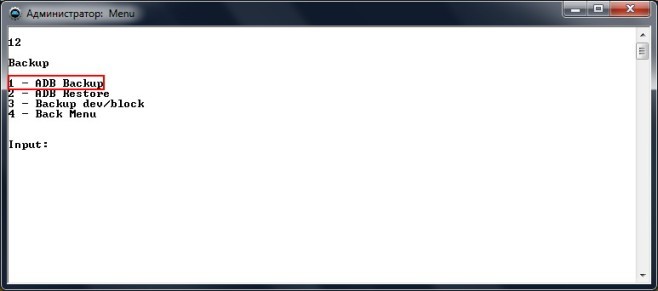
3. Take Android smartphone or tablet and click the backup button (you can not create a password)
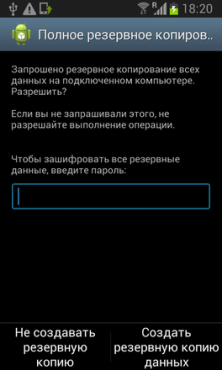
Restore from backup
1. To recover, select Adb Restore

2. Take Android smartphone or tablet and click the Recover data button
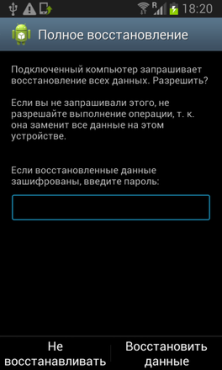
Method number 2 - using custom Recovery (root)
First of all, custom Recovery should be installed! How to do it and what, you can learn in detail from the article download and install recovery.Creating a backup is not exactly a backup - this is creating an image of the current state of the firmware
!
Once installed Recovery log in to it.
Select the Backup and Restore menu.
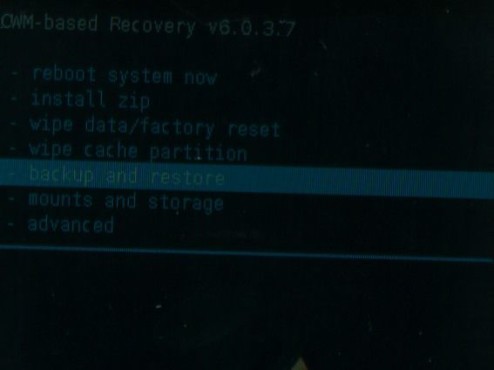
Select the Backup menu item to create a backup.
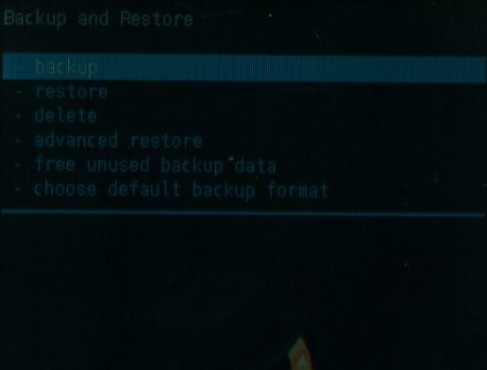
Select the Restore menu item to restore
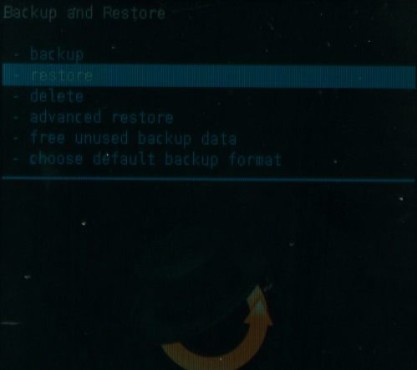
Method №4 - DataSync (root)
The DataSync program is suitable for those who need to back up application data, as well as instant movement them on other device. If you need to create backup copies of the applications directly, and not just their data and settings, then this application is not for you. In more detail how this application works Datasync.
Method number 5 - OBackup (root)
OBackup - It creates backups like Online Nandroid Backup, only this time the application has an intuitive graphical interface, and you can send a backup to a cloud drive. In detail Obackup.
Method # 6 - Titanum Backup (root)
Method number 7 - Helium (root / root)
A very interesting tool to create a backup. The principle of operation of this application is similar to the work of ADB debugging tools, more precisely based on this way, only with a choice for which application to back up. This application does not work on Motorola.
The Helium application can work without Root rights, but if they are even better (if you do not have root rights, you need Android to the computer).
How to backup with Helium?
1. First, download the app from the official Google Play app store.
 free version
free version If absent Root rights then you will also have to download and install the add-on on the PC
You may also need to install drivers on your PC ( for non Root devices), which are presented on the PC add-on download page
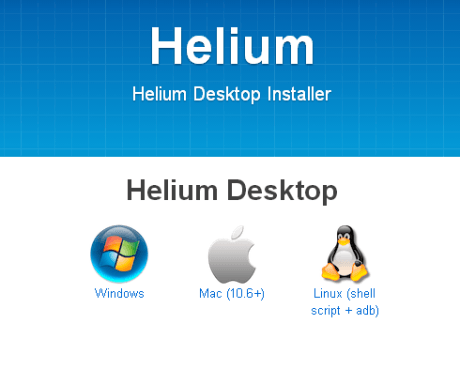
Creating rk in Helium on Root devices
Run the application, give up from the offer to enter Google diskso this function does not work quite honestly (backup, but recovery works only in the paid version of the application)

